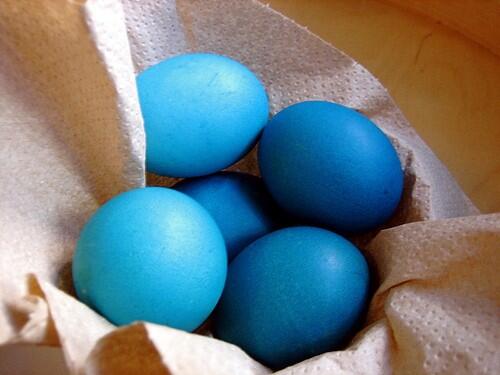Colored eggs are one of many traditions in Easter, but the ways eggs are dyed pose health threats, especially that most of the material used for coloring comes from unnatural sources. However, eggs can be colored in a fun and natural way, away from all the environmental and health threats those artificial dyes pose.
Here is a natural and fun way to color easter eggs:
1 dozen hard-cooked eggs, room temperature, or white and brown eggs, preferably not super-fresh
4 cups dye liquid made from any of the following:
- 1 cup chopped purple cabbage per cup of water — makes blue on white eggs, green on brown eggs
- 1 cup red onion skins per cup of water — makes lavender or red eggs
- 1 cup yellow onion skins per cup of water— makes orange on white eggs, rusty red on brown eggs
- 1 cup shredded beets per cup of water— makes pink on white eggs, maroon on brown eggs
- 2 tablespoons ground turmeric per cup of water — makes yellow eggs
- 1 bag Red Zinger tea per cup of water— makes lavender eggs
1 tablespoon white vinegar per cup of strained dye liquid
Neutral oil, such as vegetable or grapeseed
Pour the amount of water you need for the dye you’re making into a saucepan — you can make 4 separate batches of different colors or 1 large batch of a single color; follow the ratios given above for each ingredient to make more or less dye.
Add the dye matter (purple cabbage, onion skins, etc.) and bring the water to a boil. Turn the heat down to low and simmer, covered, for 15 to 30 minutes.
When is the dye Ready?
The dye is ready when it reaches a hue a few shades darker than you want for your egg. Drip a little dye onto a white dish to check the color. When the dye is as dark as you like, remove the pan from the heat and let the dye cool to room temperature. (I put the pot on my fire escape and it cooled off in about 20 minutes.)
Pour the cooled dye through a fine-mesh strainer into another saucepan (or into a bowl then back into the original pan if that’s all you have). Stir the vinegar into the dye — use 1 tablespoon of vinegar per cup of strained liquid.
Arrange the room-temperature eggs in single layer in a baking dish or other container and carefully pour the cooled dye over them. Make sure the eggs are completely submerged.
Refrigerate
Transfer the eggs in the dye to the refrigerator and chill until the desired color is reached. Carefully dry the eggs, and then massage in a little oil to each one.
Polish with a paper towel. Store the eggs in the refrigerator until it is time to eat (or hide) them.
Happy Easter.
Follow us on our Twitter account @greenareaen
















